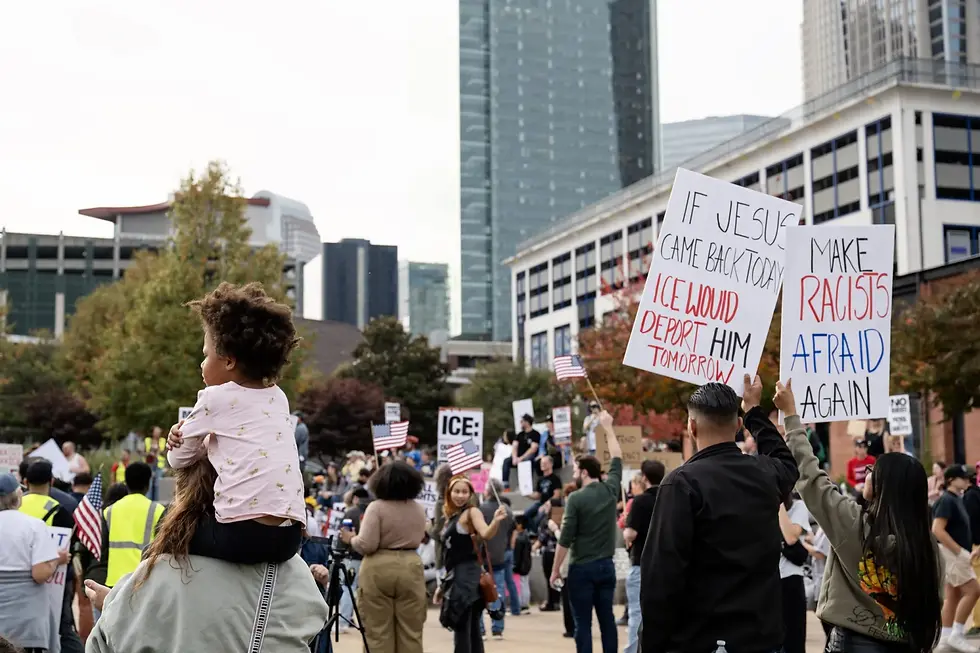THE ASSEMBLY: Fear, Protest, and Preparation As Dozens Are Reportedly Detained in Charlotte
- encore

- 2 days ago
- 5 min read
As federal immigration officers descended on the Queen City, the city’s immigrant and activist communities braced for what’s to come.
This article was written by Greg Lacour and originally published in The Assembly on November 17, 2025.

A few hours after federal immigration officers began to detain people in Charlotte on Saturday, Gerardo Aguilar did something he’d never done in his 24 years here: He joined a protest.
Aguilar, 42, is a U.S. citizen, born and raised in Chicago. His father was born in Mexico; his mother is also of Mexican descent but was born in Brownsville, Texas, just across the border. Aguilar moved to Charlotte to join his father, who owns a grocery store in the University City area, and escape the cold and violence of his hometown. He was astonished at how friendly the city was and decided to stay. Aguilar eventually started a home restoration business, a lucrative occupation in one of the nation’s fastest-growing cities.
“When I first came down here,” he said, “it was weird, because I would be walking and someone would say ‘Hi,’ and I’m like, ‘Do I know you?’ … It’s a beautiful city, a very welcoming city. Charlotte’s been growing a lot. So I’ve been growing with Charlotte.”
Aguilar had taken a seat on a concrete bench at First Ward Park in Uptown, the name Charlotteans use to refer to the city center. It was approaching 2 p.m., and as he spoke, a crowd assembled for a protest that PSL Charlotte, the local chapter of the national Party for Socialism and Liberation, organized. About 500 would eventually show up for speakers and a march, carrying signs that read, “I Like My ICE Crushed” and “Anne Frank Wrote in Her Diary About This!”
After only vague warnings in the preceding days, masked and uniformed U.S. Customs and Border Protection (CBP) officers had arrived in Charlotte’s Latino neighborhoods and started arresting people, or at least threatening to.
The CBP operation follows a two-month campaign in Chicago that the agency called Operation Midway. Aguilar said family members shared news and videos from his home neighborhood, Little Village, known as “the Mexico of the Midwest” for its large immigrant population.
“Seeing people getting knocked down, getting pulled out of trucks—innocent people, mothers just trying to protect their children—and they get pulled out,” Aguilar said. “If the people have done something bad, I understand that, I’m all for it, but the people who are innocent, just bystanders, I don’t think it’s fair.”
So Aguilar decided to join the protest to see what he could learn. “We’re the voices for the people who are undocumented. They’re in their houses right now,” he said. “But we can give them the information so they can know what their rights are and what they can do.”

Operation Charlotte’s Web
Videos of arrests in Charlotte reached news agencies and social media channels Saturday morning. A reporter for WFAE-FM filmed Border Patrol officers as they arrested a man at a shopping center on Central Avenue, the main avenue through Charlotte’s largest Latino neighborhood, at about 10:15 a.m.
Soon after, video emerged of a pair of masked CBP officers who questioned a pair of landscapers as they hung Christmas lights on a tree in Rheba Hamilton’s front yard. The officers left in an unmarked minivan as Hamilton ordered them: “Get the hell out of my yard, assholes.”
Willy Aceituno, a Honduran immigrant and U.S. citizen, told The Charlotte Observer that officers stopped him outside a south Charlotte restaurant, threw him to the ground, and broke one of his pickup truck’s windows before they let him go.
The operation, which the Department of Homeland Security is calling Charlotte’s Web, led to more arrests Sunday as residents documented and, at times, confronted agents. Border Patrol Commander Gregory Bovino claimed late Saturday that CPB had made 81 arrests in five hours.
“We are really taking it to them today here in Charlotte,” Bovino tweeted just before noon Sunday. DHS, the Border Patrol’s parent agency, has been vague about its intentions in the city and has not provided a clear reason it was chosen, how long it will last, or where officers are taking detainees.
But politics likely offers part of the explanation. Mecklenburg County Sheriff Garry McFadden was one of five sheriff candidates, all Black Democrats in urban North Carolina counties, who won office in 2018 after campaign pledges to end cooperation with federal immigration enforcement. Also, Republicans nationwide focused on Charlotte as a symbol of crime in Democrat-controlled cities after the August killing of Iryna Zarutska on the city’s light rail and reports of increased crime in the city center.
The city’s growth, and immigrants’ role in it, is probably a factor as well. Charlotte’s Latino population was minimal before the 1989 groundbreaking of Bank of America Corporate Center, still the city’s tallest building. But the construction job opened a flow of immigrant laborers, mainly Mexicans at first, who moved to the fast-growing area. As Mecklenburg County’s overall population has swelled—Charlotte is now the 14th-most populous U.S. city—its Latino share has grown from 6.5 percent in 2000 to 15.2 percent in 2020.
René Trinidad, 48, has lived in Charlotte for two decades—he said he lives and works as a permanent resident with a green card—and typifies the kind of Latino immigrant who moved here in the 2000s. He chose Charlotte for “opportunity” after he fled the cartel-related violence and crime in Chiapas state in Mexico. He still works a blue-collar job, as a painter for new construction projects, and speaks limited English.
Reached by phone Sunday, Trinidad said he, his wife, and their two children—ages 4 and 2—were staying at home in south Charlotte and had ordered food and other household supplies for delivery. He added that his current job site is in Columbia, South Carolina, and he didn’t know what might await him in the morning: “I’m nervous and scared.”

Protest and Preparation
If Operation Charlotte’s Web was meant to intimidate Latino residents, it appeared to have accomplished at least that Sunday. On a sunny, breezy afternoon in the 70s, parks, shops, and parking lots that typically bustle with families and teenagers in areas like east Charlotte were largely deserted.
Signs of resistance came mainly from groups like PSL Charlotte, which also held a protest training session Sunday at a west Charlotte co-working space. The crowd of about 120 overflowed from a reserved conference room as organizers handed out plastic whistles, which residents in other cities have used to alert each other about agents’ presence, and laminated cards that outline constitutional rights.
“L.A. fought back, and Chicago fought back,” PSL Charlotte member Zach Thomas told the throng Sunday. “Now it’s our turn in Charlotte!”
After a series of speakers Saturday, Gerardo Aguilar and the rest of the crowd at First Ward Park took to the streets of Uptown, at one point pausing in the shadow of the Bank of America building whose construction brought many Latinos to Charlotte.
The protest echoed common chants like ”No Justice? No Peace!” but achieved its highest volume toward the end, when a more profane chant directed at President Donald Trump took hold.
“We see all these innocent people taken,” said a 19-year-old protester who asked to be identified only by her first name, Katie. “These innocent fathers who do nothing wrong, getting taken out of their jobs—I mean, come on, what is that? You don’t do that. So we’re here to stand our ground. We’re not scared.”
Greg Lacour is a journalist in Charlotte. This story was originally published in The Assembly on November 17, 2025.

